Winter Flowers, Fragrance and a Funny Name
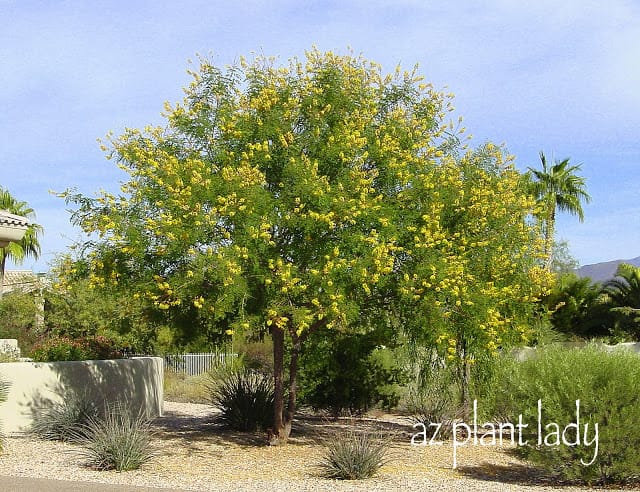
Want beautiful foliage, spectacular flowers all packaged up in a tree that blooms in fall and winter? Well, let me introduce you to a medium -sized tree with a funny name: Cascalote (Caesalpinia cacalaco).
I love this medium-sized tree with it’s circular leaves, textured bark and winter flowers. Native to Mexico, Cascalote produces beautiful yellow flowers during the cooler months of fall and winter. It is hardy to 20 degrees F, but will lose it’s leaves during if temperatures dip into the 20’s. At maturity, the approximate size is 20 ft. x 20 ft.
I bought my first Cascalote 11 years ago when my Plant Identification class took a field trip to the Boyce Thompson Arboretum. They were having a plant sale and I bought a 15-gallon size Cascalote, which I planted it against a west facing wall that received a lot of reflected sun and heat.
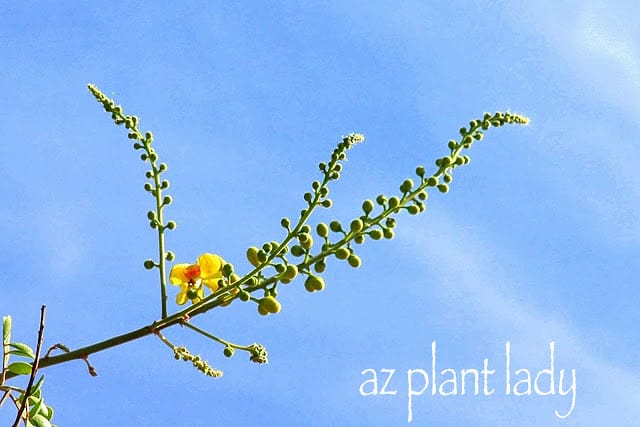
The yellow flowers are stunning when viewed against the backdrop of a deep blue sky. Early in November, they begin to produce tall spires of tightly bound yellow flower buds.
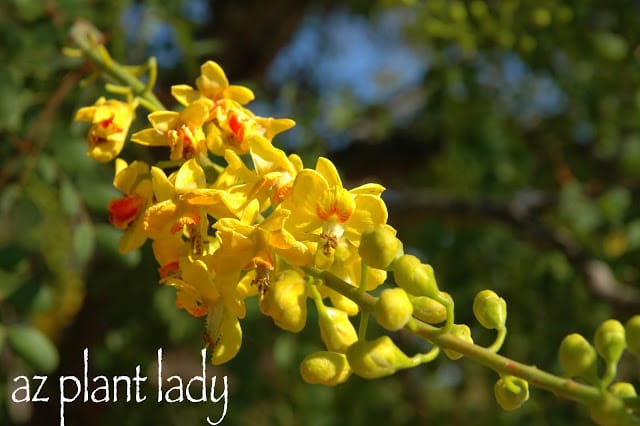
In mid to late November, the flowers begin to open, showing a blush of bright orange. In addition to being beautiful, the flowers also are lightly fragrant. The flowers are retained through February. Seed pods will soon follow the flowers.
USES: Cascalote thrives in hot locations and even in areas with reflected heat and should be planted in full sun. It looks great as the focal point of a planting area or can be used to provide shade to other plants and also makes a great patio tree.
I once planted one in a high profile corner of a commercial building with Radiation Lantana planted beneath. Because of the overlapping bloom seasons of the Lantana and Cascalote, there was always color year-round.
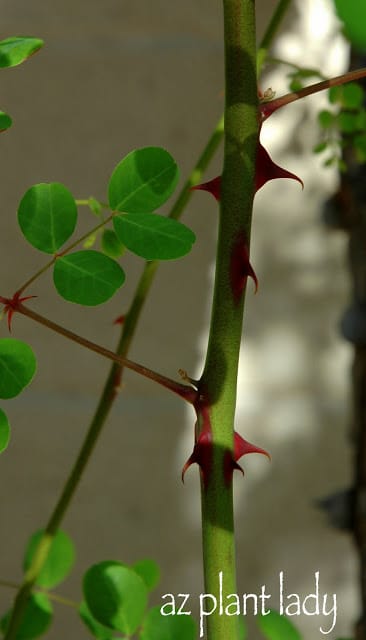
You might ask the question, “This tree sounds terrific. Are there any drawbacks?” Well, it does have thorns. Now, generally, I am not a huge fan of plants with thorns. However, I do make an exception in this case because the thorns are an ornamental feature of the tree. When the branches are young, the thorns appear maroon.
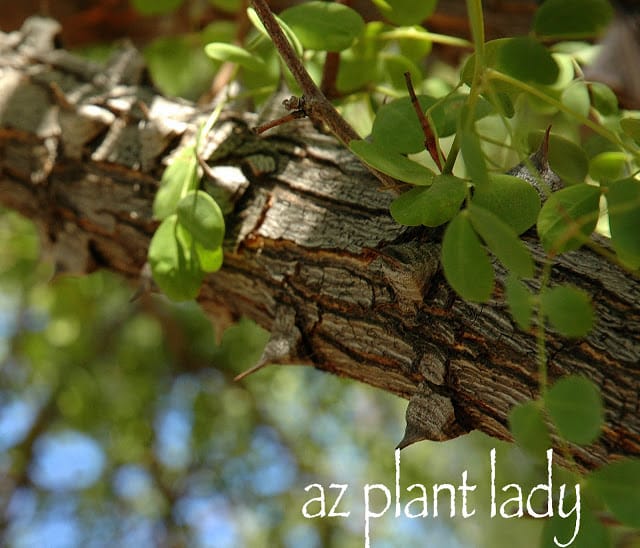
As they age, the thorns appear larger, yet still ornamental adding great texture to the appearance of the tree. That being said, I just prune off the tip of the thorns so that I don’t get scratched and the trees still retain the beauty that the thorns add.
*There is a thornless variety called (Caesalpinia cacalaco ‘Smoothie’).
MAINTENANCE: Cascalote is relatively a low-maintenance tree. It can be grown as a single or multi-trunk tree. Prune in the summer removing dead and crossing branches. Weekly irrigation is required throughout the summer and once monthly in the winter. I do not fertilize my Cascalote, but a slow-release or organic fertilizer can be applied if desired.

The nest of a Yellow Finch in my Cascalote
Occasionally, some Cascalotes have been affected in the springtime by an insect known as a Psyllid which is a tiny insect that sucks on the leaves causing the tree to lose it’s leaves. Look closely at the leaves and you will see little white dots and shiny honeydew on the leaves. The best method to take care of this problem is to diagnose it quickly and spray off the leaves with a strong jet of water everyday to help prevent more leaf loss. For those not opposed to using pesticides, applying a systemic insecticide such as Merit, (available in Bayer Advanced Garden Tree & Shrub Insect Control), will take care of the problem. If your tree has lost all of it’s leaves, they will grow back, but will require one of the two treatments in order for the tree to retain them and recover.
I have had Cascalote trees in landscape areas that I managed become infected, but by using one of the two methods above; took care of the problem. I would not hesitate to continue to use Cascalotes in the landscape because of their overwhelming, positive attributes.
I highly recommend planting this tree in your landscape. The beauty of it’s leaves, flowers and bark plus it’s ability to thrive in hot, reflected sun makes it an asset in any desert landscape.

 Noelle Johnson, aka, 'AZ Plant Lady' is a author, horticulturist, and landscape consultant who helps people learn how to create, grow, and maintain beautiful desert gardens that thrive in a hot, dry climate. She does this through her consulting services, her online class Desert Gardening 101, and her monthly membership club, Through the Garden Gate. As she likes to tell desert-dwellers, "Gardening in the desert isn't hard, but it is different."
Noelle Johnson, aka, 'AZ Plant Lady' is a author, horticulturist, and landscape consultant who helps people learn how to create, grow, and maintain beautiful desert gardens that thrive in a hot, dry climate. She does this through her consulting services, her online class Desert Gardening 101, and her monthly membership club, Through the Garden Gate. As she likes to tell desert-dwellers, "Gardening in the desert isn't hard, but it is different."

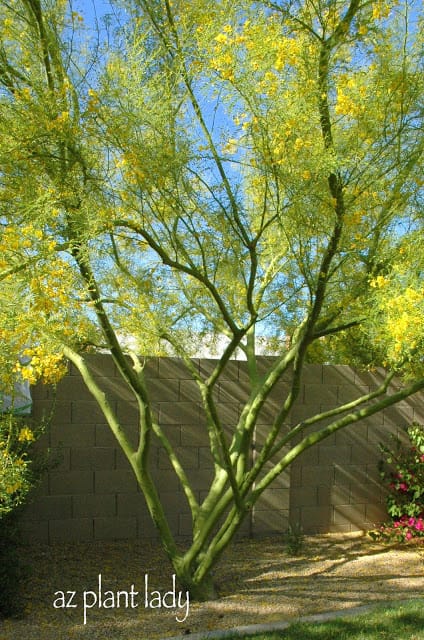








What a pretty tree…thorns and all. Hope you have a wonderful Thanksgiving.
Balisha
What a beautiful tree..gorgeous color too…very cheerful..such a lovely spotlight..I always enjoy your posts. So cool..the photo with the finches nest!
Great post!
Kiki~
Wow, is it ever gorgeous. I can't believe the flowers! Once again I so love seeing what grows where you are 🙂
Happy Thanksgiving!
Very pretty! I love the yellow blooms and the photo of the buds against the blue sky. And glad that you included the nest too!
Caesalpinia covers a huge range of shrubs, doesn't it? That's a beautiful tree.
I grow Caesalpinia pulcherrima — Pride of Barbados– which dies back to the ground here, so I expect the others will do the same. That one night in the year when the temps dip into the mid-teens is when they would be toast.
I'll stick to the broadleaf evergreens that love our damp cold.
Oh, and I ogled Cryptomeria at the nursery yesterday. A few conifers would be good, too.
It is so beautiful! And while the thorns can be a drawback, many things have thorns and so it would not dissuade me-but I would find a spot I won't brush up against it:)
Have a great Thanksgiving tomorrow.
Just beautiful and I love the mature bark!
No wonder you make an exception for thorns – this tree is gorgeous! Also, I like saying "cascolote".
'Smoothie' sounds like a great choice to me! Those thorns are definitely more scary than what I get on my roses, though not as evil-looking as the ones on the wild honey locust trees we sometimes saw in Iowa. Those were wicked.
Well it sure is a funny name. The tree is an eye stopper in any landscape… beautiful! Form, flowers, leaves and even the thorns are all lovely. I am always fascinated with the consciousness of a plant or tree that suddenly morphs from stem to thorn… it has to protect itself somehow. You are right Noelle these thorns enhance the beauty of the tree. Peace and thanksgiving to you and yours… I am truly thankful to have found you! Carol
These flowers look very similar to those yellow blooms in my place but I know this is totally a different species.
I wonder what attribute this tree to have thorns, its not creeping plant & those thorns really don't do justice to avert its predators munching on its leaves.
Hope no one prune this one & make cupcakes out of these. (lol)
This is a real gem, Noelle, thorns and all! The form and flower color really enhance the sharp agaves and other pointy plants, a nice counterpoint so to speak. Love the sweet little nest, or sweet big nest I guess. Have a wonderful Thanksgiving.
Frances
What a co-incidence, I was actually checking out seeds online a couple days ago to grow this tree for my new garden. Seeing how lovely it looks in loom I think I'll give it a try-though I already have like 20 trees for the new garden!
Hello and thank you for your kind comments and your Thanksgiving wishes.
Kiki, thank you so much for all of your positive comments!
Balisha, I hope you have a wonderful day with your family.
VW, they are kind of scary, but I have gotten used to them. But, if I were starting out with them, I probably would choose 'Smoothie' too.
Tina, a very good point. I am amazed at where thorny trees are placed in public areas. Mine is far back in my garden. I have a Bougainvillea that I get scratched regularly from, but I still love it :0)
Darla, I love the rough texture of the bark too.
JGH, thanks, I like the word too, but also like to pronounce it botanical name of 'cacalaco' too ;0)
Nell, we also grow Caesalpinia pulcherrima. I just love it's bright colors in the summer. It also dies to the ground but I can't believe how quickly it grows back.
Kanak, thank you for your comment. I just love that little nest.
Catherine, thank you for your comments. I love seeing the plants that you grow too – especially your Hydrangeas.
Hi James, I think I would literally kill anyone who tried pruning this tree into a cupcake ;0)
Thank you for your kind words, Carol. I truly enjoy your photography to much.
Hello Frances, I was so excited to find the nest. I long to put my finger inside to see if there are any eggs, but I promise I won't.
Hi Nicole, you are someone after my own heart. I love variety and I hope you have fun growing your 20 trees. I am excited you are going to try the Cascalote.
Have a wonderful Thanksgiving
vickie
It's just so hard to believe that is a tree -it's like a large snapdragon! Beautiful.
vickie
Lovely tree and lovely blog! I never had any idea that so much grew in the desert. Will be in the Thar Desert in India next week, so will look out to see what is growing there!
Nice blog with nice picture of Cascalote. I would love to grow it in my Garden. The Cascalote will make a nice patio tree. It is slow growing and only reaches at most 20 feet tall.
What a beautiful tree. Blooms like this in winter must make up for the scorching heat of summer. Happy Thanksgiving!
Gorgeous tree. I love the finch's nest. The yellow blossoms must be spectacular!!
I adore things that are yellow-colored. Now I thought of planting the same tree in my garden but I don't know where to get it. I think it's not available in our neighborhood, too bad!
Hello Vickie,
It does look a little like a snapdragon flower, except each bloom is much smaller. I hope you had a wonderful Thanksgiving too!
SweetBay, the flowers are so nice in the winter, when other plants are slowing down.
Lea, I think it may do well in Florida with the heat. Maybe you could order some seeds?
Hi MaryDelle, I do love the nest and love that the flowers are not just beautiful but fragrant.
Galloping Gardener, I am looking forward to seeing your pictures from the Thar Desert. I am always interested in seeing arid areas around the world.
Thanks again, Noelle, for always having such great information on your blog! You are creating a wealth of information for anyone starting or working on a desert garden. Good job!
Rosey
Noelle, beautiful bark and texture and what is not to like about a color that pops in your garden.
never heard of this tree before, thanks for the informative interesting post. Like you I prefer to avoid thorns but some plants are irresistable.
I love that tree, the nest and your stunning photo's. Great post as always Noelle. I do so enjoy visiting your blog.
RO :o)
Dear Author http://www.azplantlady.com !
I congratulate, the remarkable message
I love your info ! I am just starting this blog.. http://www.arizonalandscaping.blogspot.com which is for Ultimate Landscapes. We are focused on Desert Landscape Design in AZ. Your blog has a lot of good stuff. Thanks !